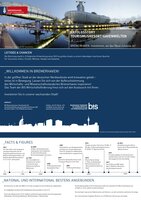
Curtain up for the Bremerhaven urban area "Werftquartier" (shipyard quarter)! Right on the waterfront, in the area of the northern fishing port, a quarter will be created that unites the districts of Geestemünde and Wulsdorf and focuses on sustainable construction and living. A mixture of commercial, residential, recreational and research and development space is planned on around 140 hectares, which will create additional living space for around 6,000 people and around 4,000 jobs.
Parts of the previous site were dominated by the industrial sector of the former Seebeck shipyard and will be transformed from a purely industrial area into a versatile commercial and residential area in the future. BIS Economic Development Company is acting as project manager for the development.
With the touristic area "Schaufenster Fischereihafen", Bremerhaven has created a maritime mile since the mid-1990s that is not only an attraction for tourists, but also offers plenty of variety for locals thanks to the establishment of restaurants and regular events. In 2018, the city council decided to build the new sustainable Werftquartier district right next door. The urban development framework plan by Copenhagen-based architects COBE was selected in a public tender.
The recipe for the new shipyard quarter is a unique mix: take the water and combine it with green spaces and urban areas that preserve the character of the location. This combination holds enormous potential for a diverse and creative urban quarter with a high quality of life. Lord Mayor Melf Grantz emphasizes: "The Werftquartier combines tradition with innovative ideas and creates a sustainable new district with great appeal, especially for young and young-at-heart residents."
Life is already happening here today. The Schaufenster Fischereihafen is an attraction for tourists and locals alike and has become an integral part of the cityscape.




Young families and scientists in particular are to find a new, attractive home in the Werftquartier with short commuting distances directly on the waterfront. A large part of the area is earmarked for new living space, with a total of 262,615 m² spread across the entire site. The Külken peninsula takes up the largest part of this.
In order to create an appropriate distance between the residential areas and the promenade, all apartments along the promenade have been arranged on the mezzanine floor. Spacious terraces with integrated greenery or green zones serve as a buffer to the surroundings and provide privacy. The possibility of creating spacious gardens facing the park is also being considered. In urban areas, apartments are arranged from the first floor or raised first floor. In existing buildings, communal front zones can be created.
With the mobility concept for the Werftquartier, a change towards less dependence on cars is being put into practice. It is not only about alternatives to conventional vehicles, but also about the seamless integration of different modes of transportation. This results in an urban environment characterized by "shared streets" - where cycling, pedestrian traffic, social interaction, parking and limited car traffic merge together. The declared aim is to establish a shared public space that shapes the cityscape in a sustainable way.
The transport infrastructure in the Werftquartier is mainly characterized by three connection points to Georgstraße and the superordinate road network for motor vehicle traffic. The detailed development is realized via special roads, which are designed as multi-use areas and largely function as one-way streets. There are also plans to set up eight mobility hubs. These will serve as central hubs and link the various modes of public transport, car-sharing and bicycle stations. The maximum access radius between the individual hubs is 250 meters, so that destinations can be reached quickly and via short routes.
"A sustainable district of the future with completely new mobility behavior."
The construction of a science campus is planned in the Werftquartier to promote the proximity of the scientific institutes. This campus not only offers attractive opportunities for employees and guests of the institutes, but also creates a place for uncomplicated exchange and collaboration with other research institutions. At the same time, it enables short commutes to work by living in the immediate vicinity, which leads to an enrichment of time. The proximity to a wide range of leisure activities rounds off the attractive overall package.
The design of the Werftquartier as such not only offers a more attractive location and more space, but also attracts skilled workers. The idea of creating flexible spaces on the science campus in which teams from various institutions, business, society and politics can come together and work together in changing project groups as required promises an innovative and dynamic working environment. This contributes to the attractiveness of the Werftquartier as a new center for the exchange of knowledge. The Bremerhaven University will also provide tomorrow's specialists with an ideal start to their future in the seaside city.
Special attention is being paid to the needs of children and young people in the development of the Werftquartier. The plans include various parks with play areas, sports facilities and meeting places for all age groups. The result is an inviting atmosphere that conveys the feeling of a communal living room and offers an attractive quality of stay. This will allow children and young people to develop in their leisure time and be integrated into the everyday life of the neighborhood from the outset.
Speaking of leisure: Bremerhaven already has a wide range of leisure and cultural activities for all generations. In the new shipyard quarter, these existing offers are to be expanded with additional ideas and a lively environment. These include chill-out areas right by the water, urban gardening and an expanded range of restaurants. The diversity of living spaces in the Werftquartier will create a dynamic and inspiring environment for youth, leisure and culture.
The unique character of the Werftquartier builds on an already established identity. What do the existing stakeholders value about the location and what do they hope for from the development of the quarter? Find out more about the Werftquartier in the brochure or on the website.
